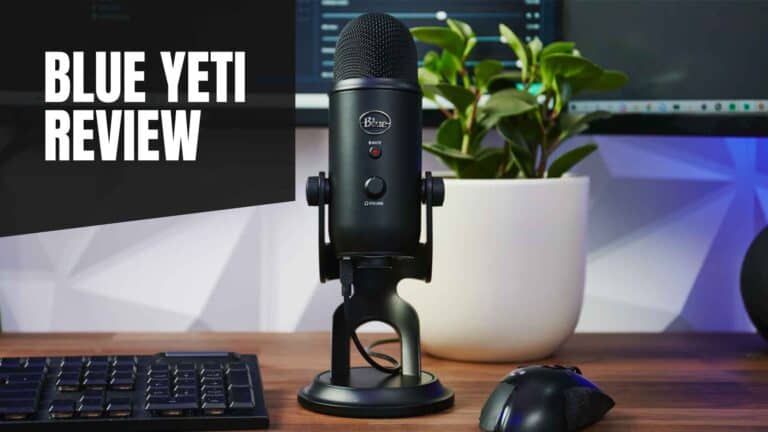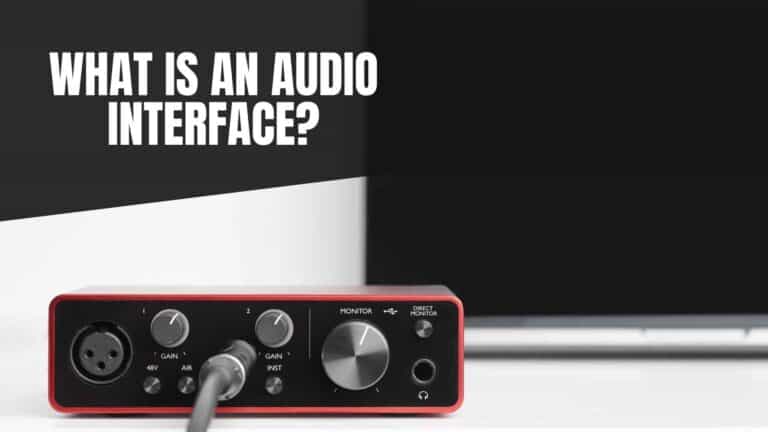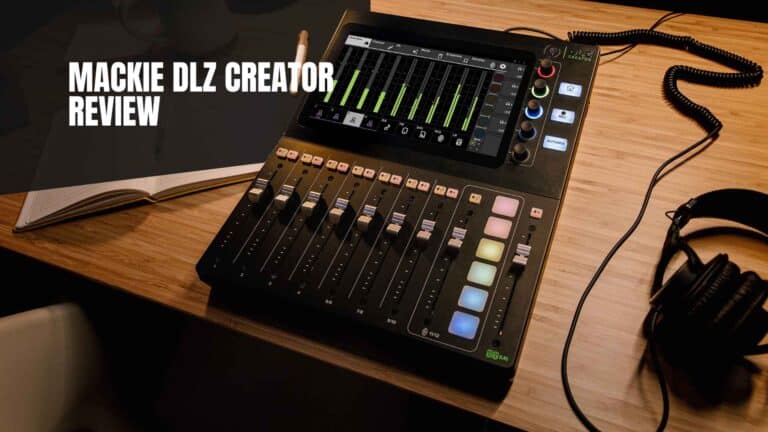Royer R-121 Review: The Mic That Made Ribbon Mics Great Again
Few microphones have garnered as much attention and acclaim as the R-121 ribbon mic from Royer Labs. With its iconic design and groundbreaking features, it has redefined what we expect from ribbon microphones.
In this comprehensive Royer R-121 review, we’ll explore its pros and cons, design intricacies, and the unique sound quality that has made it a favorite among industry professionals.
Whether you’re a seasoned audio engineer or just a curious enthusiast, join us as we uncover the magic behind the mic that claims to have made ribbon mics great again.
At a Glance
The R-121 from Royer Labs, with its iconic design handcrafted in California, is a mic that exudes vintage charm. Its sound quality is unparalleled, delivering warm, velvety tones that capture every nuance of instruments and vocals.
While it boasts many strengths, from its ability to handle very loud sounds to its lifetime warranty, it does come with a hefty price tag. However, its few flaws are overshadowed by its impeccable build and sound quality.
Pros
Cons
Background of Ribbon Microphones
The RCA 44, perhaps the most classic ribbon microphone, was invented by Dr. Harry F. Olson and became a staple in radio networks and television stations during the 1930s.
They’re so iconic that you might recognize them from vintage black-and-white photos featuring legends like Elvis Presley and Frank Sinatra.
However, ribbon microphones began to fall out of favor in the 1950s as condenser microphones gained popularity. Condenser mics captured more exaggerated high-end details, which were then rolled off during tape recording and audio transfer to vinyl. The end result was a smooth and detailed top end when using a condenser microphone, while the ribbon mic could sound muddled.

The landscape shifted with the advent of digital recording in the 1990s. Without the natural roll-offs provided by tape machines, condenser mics often sounded overly harsh in the high frequencies. Every flaw and sharp edge of the condenser mic became evident in digital recordings.
In this new context, ribbon mics began to regain popularity for their warm and pleasant sound due to the clarity of digital recordings. However, a significant drawback remained: ribbon microphones were typically large and delicate, and their ribbons could easily be damaged when exposed to loud sounds.
Enter the Royer R-121 ribbon mic in 1998, the mic that would make ribbon mics great again. This microphone revolutionized the ribbon mic category, transforming what was once a bulky and fragile device into a lightweight, durable mic capable of handling high sound pressure levels from a drum kit, to brass instruments and electric guitars.

The R-121 became so popular worldwide that countless artists have used it, including Foo Fighters, Green Day, Blink-182, Aerosmith, Van Halen, Muse, Diana Krall, Sam Smith, Lana Del Rey, and many more.
Design and Build Quality

The quality of the Royer R-121 ribbon mic is assured by the fact that each one is handcrafted in California. It has a sleek, vintage look with its satin nickel finish and does not have any mic controls like modern USB mics, other than an XLR port.
A significant portion of the manufacturing process, such as polishing the microphone housing, milling the steel block for the transducer, cutting the ultra-thin aluminum strip, corrugating it to shape the ribbon element, and positioning the ribbon between the magnets, is done manually.
These meticulous processes demand utmost care and precision, as any miscalculated move could damage the extremely delicate ribbon.

The Royer R-121 comes in a stylish lacquered wooden box, complete with a microphone clip and a mic sock designed for storing the ribbon microphone. A neat trick you can try is using the mic sock as a windscreen or pop filter to help reduce plosives. You’ll be surprised at just how effective it can be!
However, you might also want to add on Royer’s sling shock mount to help deal with any shocks or bumps in the studio.
Using Smaller and More Powerful Magnets

The earliest ribbon microphones, like the RCA 44-series ribbon mics used at Radio City Music Hall in New York in the 1930s, were bulky and heavy due to their large magnets required to generate powerful enough magnetic fields.
For instance, the RCA 44BX weighs a hefty 7.56 lbs (3.43kg). Nowadays, we often complain if a microphone weighs more than 2 lbs!
Back in the day, ribbon microphones like the RCA 44-BX utilized Alnico 5 and Alnico 8 magnets. This trend persisted until the introduction of Rare Earth Neodymium magnets, often referred to as ‘The World’s Strongest Magnet,’ in the 1980s. The pull between two of these magnets is so strong it can pass through a human hand.
Since then, these magnets have been incorporated into many dynamic microphones (indeed, a ribbon mic is a type of dynamic mic), including the Royer R-121 ribbon mic, allowing it to pull more energy from the ribbon element to produce a more detailed sound.

The adoption of Neodymium magnets enabled the Royer R-121 to have a compact ribbon and magnet assembly, fitting snugly into the 1-inch diameter microphone cylindrical housing. Thanks to the lightweight ribbon assembly, the mic weighs only 0.54 lbs (243g).
Yet, its light weight doesn’t compromise its durability. The sturdy steel housing shields the microphone from shocks and falls. Royer is so confident in this microphone’s build quality that they offer a lifetime warranty for it.
Ultra-Thin Corrugated Aluminum Ribbon
At the core of every ribbon microphone is its ribbon element. The thinner this element is, the more adept it becomes at capturing intricate sound details.

The Royer R-121 ribbon mic employs an ultra-thin 2.5-micron aluminum sheet for its ribbon element. This sheet is so delicate that it can crumble with the slightest touch. For context, a human hair measures approximately 170-180 microns in thickness. This means it would take around 70 of these sheets stacked together to match the thickness of a single hair strand!
However, possessing the thinnest possible ribbon isn’t the sole determinant of quality; the treatment it undergoes can significantly influence its performance.

The earliest RCA 44 ribbon mics were treated by placing the ribbon strip between two sheets of glassine paper and then passing it through a pair of gears. This method, however, had a drawback: if the mic was positioned horizontally, the ribbon would sag over time, leading to a loss of tension.

In contrast, Royer pioneered a precise corrugation technique using a pair of calibrated gears, eliminating the need for glassine paper. This approach results in more corrugation points than the conventional method, ensuring the ribbon becomes exceptionally tight and resilient due to the work hardening of the aluminum strip.

Given the tightness of the corrugation, the ribbon must be gently stretched to relax it before being clamped down. After mounting the ribbon onto the transducer, it’s necessary to blow into the ribbon to loosen it further.
Transducer

The transducer of the Royer R-121 ribbon mic is milled from a steel block to form a frame in which the magnets and ribbon are positioned. Grooves are carved into the transducer frame, allowing it to slide into the cut-out slot of the microphone housing.
Before the transducer is pushed all the way into the microphone slot, some cotton wool is stuffed into the electronic component of the microphone barrel to prevent the transformer wires from rattling.

The transducer frame resembles protruding ears on the microphone case. Its purpose is to concentrate the magnetic energy around the ribbon element and reduce any stray external magnetic fields. Nevertheless, it can still attract lightweight metallic objects, such as paper clips.
A thin dampening screen is placed in front of the ribbon to restrict the movement of the ribbon microphone, though most people would think it’s there for wind protection.
Offset Ribbon Design

The Royer R-121 ribbon mic features a patented ‘Offset Ribbon Design’ that enables the mic to record high sound pressure levels without distorting the sound.
This is achieved by positioning the ribbon element slightly forward between the permanent magnets. When exposed to a loud sound source, the ribbon bends but remains within the magnetic field.
This design ensures that the sound does not break up and is free from distortion, even when capturing loud instruments such as electric guitars or drum kits.
Sound Quality

The remarkable design of the Royer R-121, combined with precision manufacturing, accounts for its superior sound quality. In fact, Royer asserts that the R-121 was the first ribbon microphone capable of close-miking electric guitar amps without concerns over high sound pressure levels.
The Royer R-121 boasts a maximum SPL rating of 135dB at 20Hz, which is exceptionally high for a ribbon mic. It can seamlessly handle everything from a blaring guitar amp to kick drums and brass instruments, producing a silky smooth sound without distortion. Aside from proximity effect, it has a pretty consistent frequency response regardless of distance from the sound source.
David Royer, the founder of Royer Labs, harbors a profound appreciation for classical music. His initial design objective for the Royer R-121 ribbon mic was to capture every note of a pipe organ authentically.
However, over the years, whether due to marketing, branding, or common usage patterns, the R-121 became synonymous with recording the crunch and distortion of electric guitar amps.

In fact, Joe Perry was so fond of the Royer R-121 ribbon mics that he employed them not only for his studio recordings but also on guitar cabs for Aerosmith’s live stage performances during the Just Push Play tour in 2001. This marked the first known instance where Royer microphones were used outside of a studio setting in a live performance.
Many describe its tone on electric guitars as realistic and balanced, characterized by a rich bass, detailed mids, and smooth highs. This contrasts sharply with the overly bright sound of a Shure SM57, which lacks depth in the low-end, or the overly clinical sound of a condenser mic.

However, a common practice used by electric guitarists is to pair the R-121 with a dynamic mic, such as the Shure SM57, using a dual-mic clip like the SM-21 AxeMount when miking a guitar amp. This combination yields a composite tone, blending the warm and smooth sound of the R-121 with the punchy, bright sound of the SM57.
If you need help finding the best dynamic mic for your needs, we have some great recommendations in this article.

Recording brass instruments often poses a challenge for many microphones, as the sound can be aggressively piercing in the high-end. Yet, the R-121 offers a smooth, high-end response that avoids harshness while preserving detail with clarity and precision.

The Royer R-121 imparts a velvety, warm, and smooth quality to vocals and stringed instruments like cellos and violins, capturing them with lifelike authenticity without sounding shrill or piercing. In fact, the mic’s unparalleled fidelity makes it a top choice for recording choirs and orchestras.
It’s often used in conjunction with other Royer microphones, such as the R-122V, SF-24, SF-2, and SF-24V, to record The Tabernacle Choir at Temple Square (previously known as the Mormon Tabernacle Choir) and The Millennial Choirs and Orchestras.

By design, the R-121, being a ribbon mic, has a bi-directional polar pattern. If you remember the ‘Offset Ribbon Design,’ its purpose isn’t solely to enable the microphone to record high SPL without sound distortion. It also allows the rear end of the R-121 to capture audio with a brighter tone – quite an unusual phenomenon, given the R-121’s attenuated frequency response above 10kHz.

This distinctive feature of the R-121 proves beneficial when recording acoustic instruments like the harp, acoustic guitar, or piano, truly allowing your instrument to resonate and its high notes to shimmer.
If you are using an inexpensive audio interface or preamp, the gain from the R-121 may not be sufficient. In such cases, consider adding a CloudLifter or Royer’s dBooster in-line booster to achieve a higher level of clean gain.
Final Verdict

The R-121 from Royer Labs stands as a testament to high-quality craftsmanship and impeccable sound quality.
This ribbon microphone, with its rich heritage and revolutionary design, has not only revived the golden era of ribbon mics but has also set a new benchmark for others to follow.
Its warm, velvety tones, combined with its robust build and iconic design, make it a must-have for professionals and enthusiasts alike.
From the studios of legendary artists to the stages of world-renowned performers, the R-121 has proven its mettle time and again. Its ability to capture the nuances of instruments and vocals with unparalleled clarity is nothing short of remarkable.
While its price point may be a consideration for some, especially with other more affordable and modern vocal mics out there, the investment is justified by its performance, durability, and the lifetime warranty that accompanies it.
Whether you’re recording a soulful ballad, a roaring guitar solo, or an orchestral masterpiece, the R-121 promises to deliver a sound experience like no other ribbon mic.
If there’s one microphone that truly made ribbon mics great again, it’s undoubtedly the Royer R-121.
Production Information
Specifications
- Polar pattern: Figure-8
- Circuit Type: Passive ribbon
- Power requirements: N/A
- Frequency Response: 30 Hz to 15,000 Hz
- Sensitivity: -47 dBV/Pa (4.47 mV/Pa) @1kHz
- Max SPL: 135 dB
- Output Connection: XLR, 3-pin, male
- Weight: 8.6oz (244g)
- Accessories: Protective wooden case, mic sock

Royer R-121









